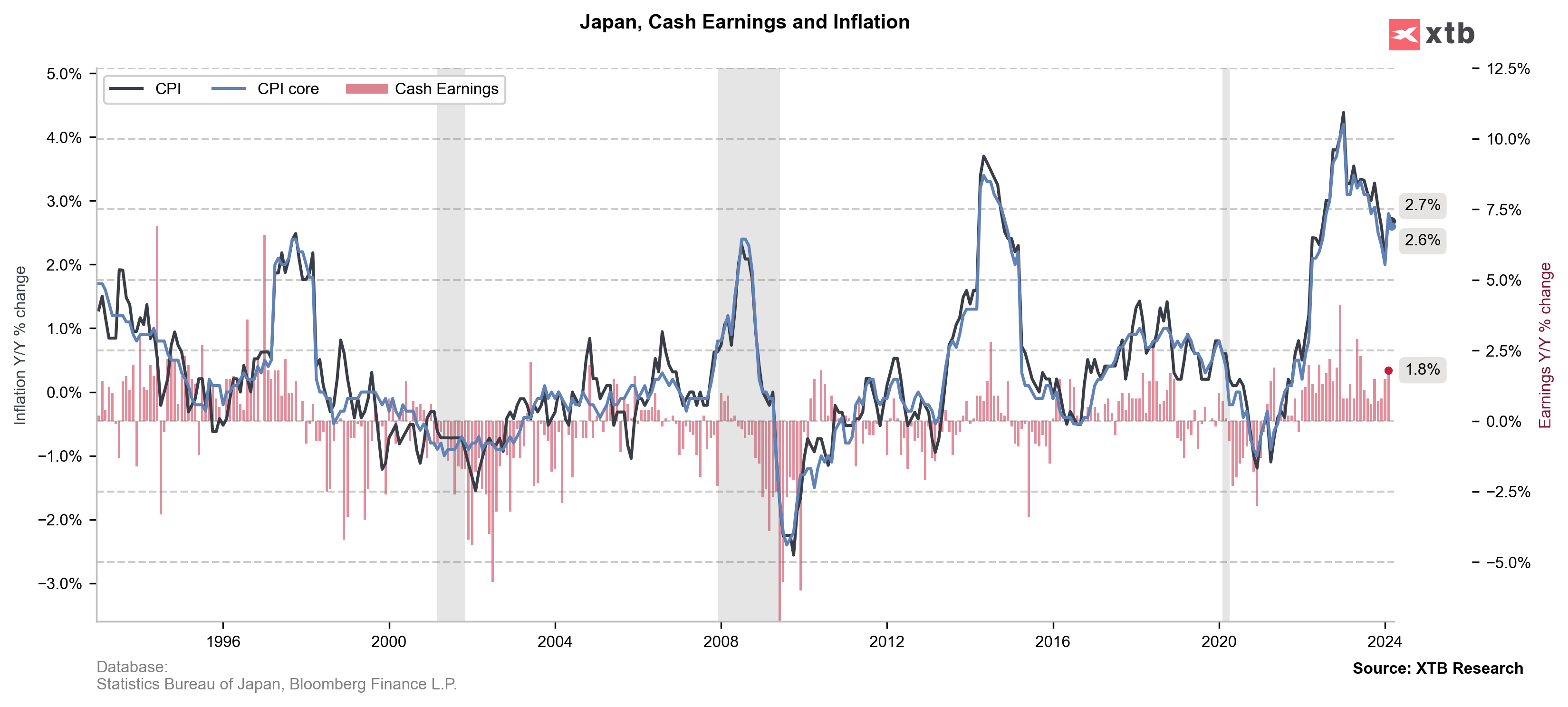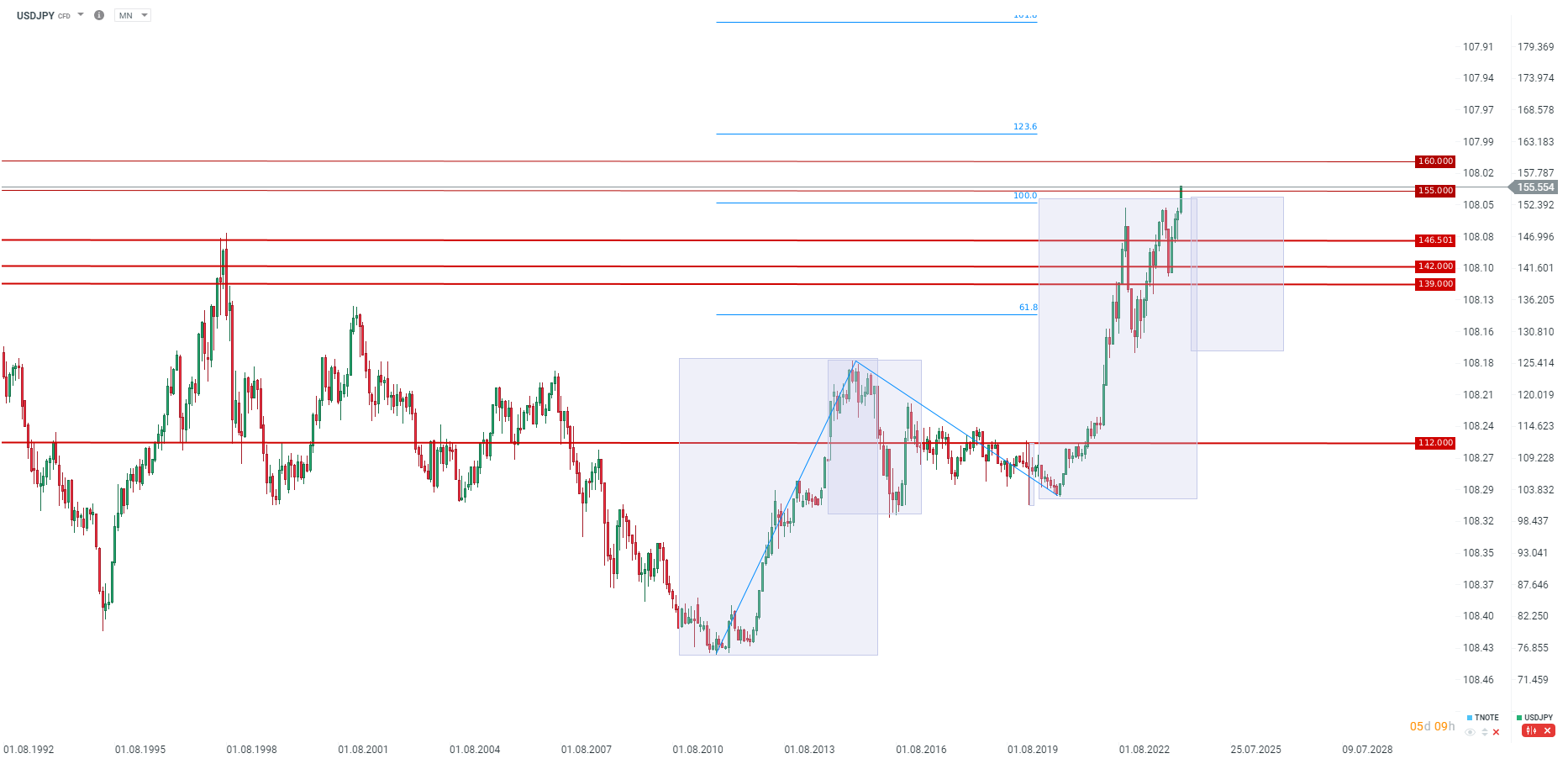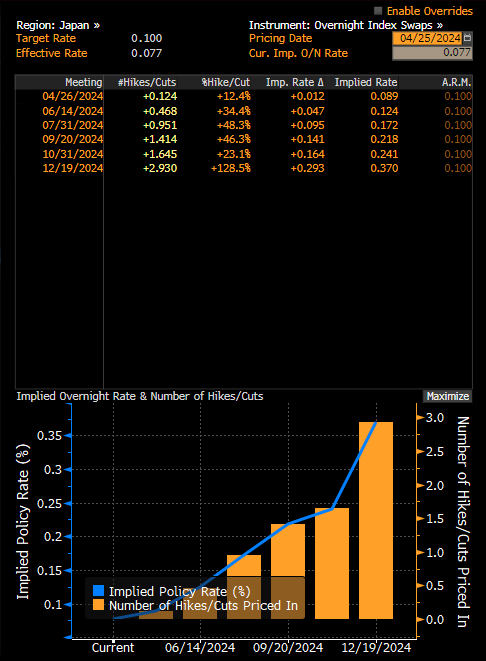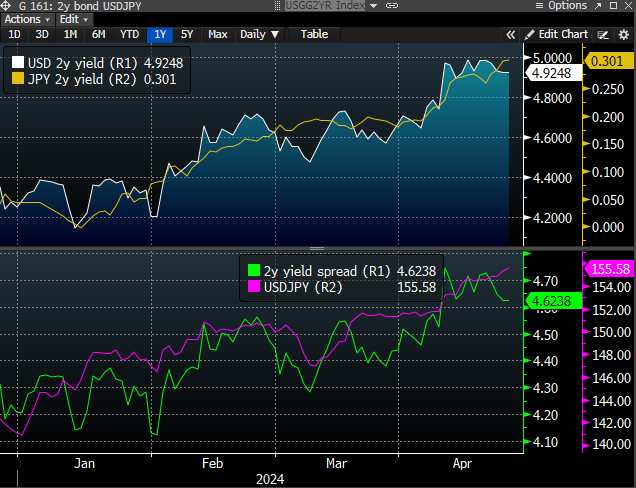- The BoJ raised the interest rate for the first time since 2007 at its March meeting
- The bank also lifted its yield curve control program and reduced its overall asset purchase program, but maintained its government bond purchase program.
- No changes are expected at the April meeting, but expectations are rising for a move in June or July, which is linked to the yen's weakness
- The yen is currently at its weakest in 34 years. Weakness of one could put more upward pressure on inflation
- USDJPY breaks through the 155 level, which was assessed as the next frontier for intervention
Japanese interests rates probably unchanged
It is almost 100% certain that the BoJ will not raise interest rates at tomorrow's meeting. If there were a change, it would mean a hawkish pivot on the part of Ueda. This one has indicated repeatedly in recent times that policy must remain accommodative to make sure inflation reaches its target in the long term. At the same time, Kazuo Ueda has indicated that he wants to raise interest rates again this year, but this will depend on the trend of core inflation. If the BoJ decides to raise forecasts for core inflation, then a positive reaction on the yen is possible, although on the other hand we still have a very strong U.S. dollar, which is unlikely to have reasons for weakness in the near term. The BoJ is expected to raise its core inflation forecast from 2.4% to 2.6% for fiscal 2024, from 1.8% to 2.0% for fiscal 2025, and show its first forecast for 2026 at 2%. It is this information that could be key to the medium-term outlook for interest rates and the yen.
Higher wages allowed for a hike in March. Will higher inflation forecasts give a chance for a mid-year hike? Source: Bloomberg Finance LP, XTB
Intervention on the yen?
The USDJPY pair rose to its highest levels in 34 years. The pair pierced the 155 level, which had previously been assessed as a likely site for government intervention. Japanese authorities have shown concern over the yen's weakness, but other than verbal intervention, no action has been taken. Japan last intervened in 2022, which cost close to $60 billion... And finally failed.

USDJPY pierces the 155 level In addition, we observe that the pair pierces the level associated with the range of the previous large upward wave from 2012-2015. Nevertheless, if the BoJ would be very hawkish during the meeting, a retreat to the area of 153.5 is not excluded, which would generate a potentially very strong pro-decline signal. On the other hand, at this point there is rather talk of a moderate further weakening of the yen and a rise even in the vicinity of 160. Source: xStation5
When is the next downgrade?
At this point, indications are that the earliest possible hike could take place in September or October. On the other hand, if inflation surprises with higher readings, oil continues to rise and USDJPY rises to above 160, an earlier move by the Bank of Japan cannot be ruled out. Ueda pointing to the possible effects of a second round on inflation could suggest an earlier move than this fall. If so, it would be a hawkish surprise, but at the same time, Ueda has rarely sounded hawkish since the beginning of his tenure. Nevertheless, he also indicated in March that the BoJ would consider reducing bond purchases at some point. The start of "QT" could also be a hawkish surprise for the market.
The market is pricing in a cumulative probability of a near-full cut in July, while the consensus from economists tends to point to September or October. Source: Bloomberg Finance LP, XTB
Is there hope for the yen?
Higher inflation forecasts, possible attention to the second-round effect, potential QT or a weak yen triggering import inflation. All these factors give the chances that the yen is already close to its bottom. On the other hand, we are used to disappointment from the BoJ or Japanese government action. Nevertheless, we are already seeing quite strong increases in Japanese yields, which may work in favor of the yen at some point. On the other hand, as long as the dollar remains strong, it is hard to expect the trend on the yen to change. At this point, further speculation is that intervention is possible, with the USDJPY pair reaching the 160 level.

Short-term yields in Japan have scored a fairly large increase recently, with US yields stabilizing. Source: Bloomberg Finance LP, XTB
Daily summary: Wall Street tries to stop the sell-off 📌Gold down 1.8%, Bitcoin loses 4.5%
BREAKING: Canadian Wholesale & Manufacturing Sales higher than expected 📊USDCAD reacts
BREAKING: EU GDP data slightly above expectations! 📈💶
BREAKING: French and Spanish inflation came in line with expectations 📌
The content of this report has been created by XTB S.A., with its registered office in Warsaw, at Prosta 67, 00-838 Warsaw, Poland, (KRS number 0000217580) and supervised by Polish Supervision Authority ( No. DDM-M-4021-57-1/2005). This material is a marketing communication within the meaning of Art. 24 (3) of Directive 2014/65/EU of the European Parliament and of the Council of 15 May 2014 on markets in financial instruments and amending Directive 2002/92/EC and Directive 2011/61/EU (MiFID II). Marketing communication is not an investment recommendation or information recommending or suggesting an investment strategy within the meaning of Regulation (EU) No 596/2014 of the European Parliament and of the Council of 16 April 2014 on market abuse (market abuse regulation) and repealing Directive 2003/6/EC of the European Parliament and of the Council and Commission Directives 2003/124/EC, 2003/125/EC and 2004/72/EC and Commission Delegated Regulation (EU) 2016/958 of 9 March 2016 supplementing Regulation (EU) No 596/2014 of the European Parliament and of the Council with regard to regulatory technical standards for the technical arrangements for objective presentation of investment recommendations or other information recommending or suggesting an investment strategy and for disclosure of particular interests or indications of conflicts of interest or any other advice, including in the area of investment advisory, within the meaning of the Trading in Financial Instruments Act of 29 July 2005 (i.e. Journal of Laws 2019, item 875, as amended). The marketing communication is prepared with the highest diligence, objectivity, presents the facts known to the author on the date of preparation and is devoid of any evaluation elements. The marketing communication is prepared without considering the client’s needs, his individual financial situation and does not present any investment strategy in any way. The marketing communication does not constitute an offer of sale, offering, subscription, invitation to purchase, advertisement or promotion of any financial instruments. XTB S.A. is not liable for any client’s actions or omissions, in particular for the acquisition or disposal of financial instruments, undertaken on the basis of the information contained in this marketing communication. In the event that the marketing communication contains any information about any results regarding the financial instruments indicated therein, these do not constitute any guarantee or forecast regarding the future results.


